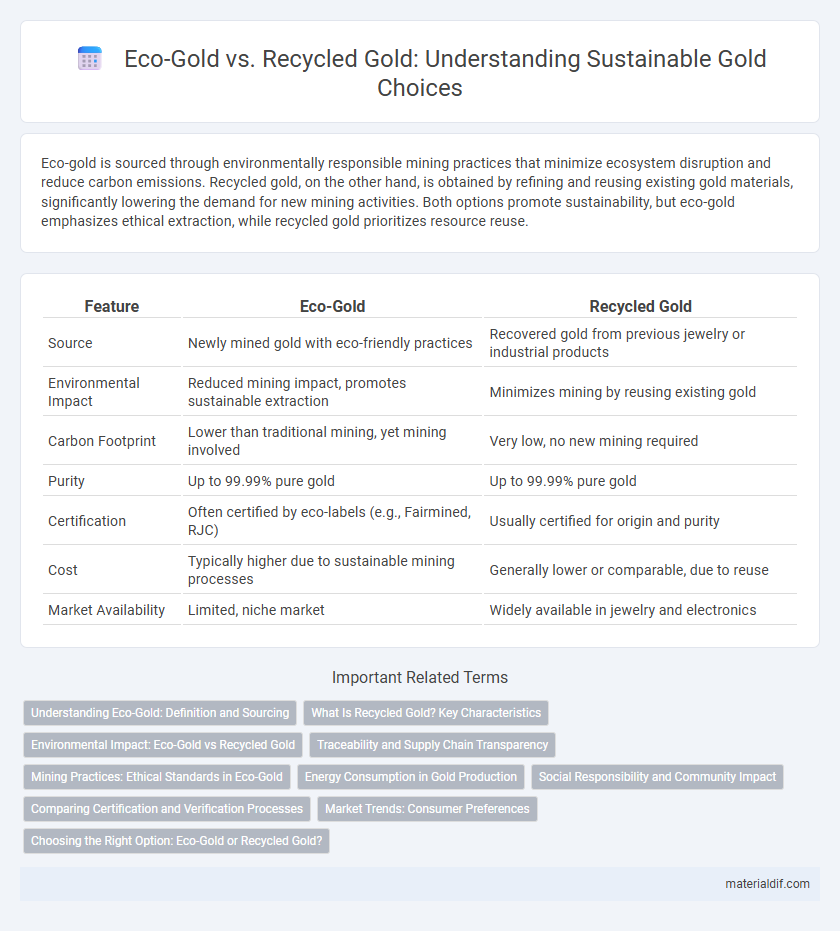Eco-gold is sourced through environmentally responsible mining practices that minimize ecosystem disruption and reduce carbon emissions. Recycled gold, on the other hand, is obtained by refining and reusing existing gold materials, significantly lowering the demand for new mining activities. Both options promote sustainability, but eco-gold emphasizes ethical extraction, while recycled gold prioritizes resource reuse.
Table of Comparison
| Feature | Eco-Gold | Recycled Gold |
|---|---|---|
| Source | Newly mined gold with eco-friendly practices | Recovered gold from previous jewelry or industrial products |
| Environmental Impact | Reduced mining impact, promotes sustainable extraction | Minimizes mining by reusing existing gold |
| Carbon Footprint | Lower than traditional mining, yet mining involved | Very low, no new mining required |
| Purity | Up to 99.99% pure gold | Up to 99.99% pure gold |
| Certification | Often certified by eco-labels (e.g., Fairmined, RJC) | Usually certified for origin and purity |
| Cost | Typically higher due to sustainable mining processes | Generally lower or comparable, due to reuse |
| Market Availability | Limited, niche market | Widely available in jewelry and electronics |
Understanding Eco-Gold: Definition and Sourcing
Eco-Gold refers to gold that is mined using environmentally responsible methods that minimize ecological impact and promote sustainability. Its sourcing involves strict adherence to standards that reduce water usage, prevent toxic chemical release, and ensure fair labor practices, distinguishing it from conventional gold mining. This approach prioritizes transparency and traceability throughout the supply chain to maintain ecological balance and social responsibility.
What Is Recycled Gold? Key Characteristics
Recycled gold is refined from pre-existing jewelry, electronics, or industrial gold waste, reducing the need for new mining activities and minimizing environmental impact. It retains the same chemical composition (24 karat purity) as newly mined gold, ensuring identical quality and durability for use in jewelry and electronics. This sustainable sourcing method supports eco-friendly practices by conserving natural resources and lowering carbon emissions associated with traditional gold extraction.
Environmental Impact: Eco-Gold vs Recycled Gold
Eco-gold is sourced through sustainable mining practices that minimize habitat destruction and reduce carbon emissions by utilizing renewable energy and water recycling technologies. Recycled gold, on the other hand, significantly lowers environmental impact by reusing existing gold from electronic waste and old jewelry, eliminating the need for new mining altogether. Both methods drastically reduce pollution and resource depletion compared to conventional gold mining, but recycled gold holds the advantage in conserving natural ecosystems by avoiding extraction processes.
Traceability and Supply Chain Transparency
Eco-Gold prioritizes traceability through rigorous certification systems like Fairmined, ensuring ethical sourcing from verified mines with transparent supply chains. Recycled gold enhances supply chain transparency by originating from pre-existing jewelry and industrial materials, reducing environmental impact and guaranteeing third-party verification of its lifecycle. Both approaches advance sustainable gold consumption but differ in source origin and verification methods.
Mining Practices: Ethical Standards in Eco-Gold
Eco-Gold is sourced from mining operations that prioritize sustainable practices, minimizing environmental impact through rigorous land reclamation and water conservation measures. Ethical standards in Eco-Gold mining include fair labor practices and community engagement, ensuring respect for human rights and local livelihoods. In contrast, recycled gold bypasses mining entirely, reducing ecological footprint by repurposing existing metal with zero new extraction.
Energy Consumption in Gold Production
Eco-Gold production significantly reduces energy consumption compared to traditional mining methods by utilizing sustainable practices such as solar power and low-impact extraction techniques. Recycled gold also lowers energy demand by eliminating the need for ore extraction, cutting energy use by approximately 90% relative to newly mined gold. Both eco-gold and recycled gold present more energy-efficient alternatives essential for reducing the environmental footprint of gold production.
Social Responsibility and Community Impact
Eco-Gold is mined using environmentally friendly techniques that reduce water consumption and avoid toxic chemicals, supporting sustainable livelihoods for local communities by providing fair wages and safe working conditions. Recycled Gold minimizes environmental degradation by repurposing existing gold, significantly lowering carbon emissions and reducing the demand for new mining operations. Both approaches promote social responsibility, but Eco-Gold emphasizes direct community development, while recycled gold focuses on resource conservation and waste reduction.
Comparing Certification and Verification Processes
Eco-gold certification typically involves rigorous environmental and social standards verified by third-party organizations like the Responsible Jewellery Council (RJC) or Fairmined, ensuring responsible mining practices and minimal ecological impact. Recycled gold certification primarily emphasizes traceability and the authenticity of recycled material, verified through chain-of-custody standards such as those set by the London Bullion Market Association (LBMA) or Responsible Jewellery Council. Comparing the two, eco-gold certifications focus more on sustainable sourcing from mining operations, while recycled gold verification centers on confirming recycled content and preventing contamination or mixing with newly mined materials.
Market Trends: Consumer Preferences
Eco-gold and recycled gold are gaining significant traction in consumer markets due to increased environmental awareness and ethical sourcing demands. Market trends indicate a growing preference for eco-gold over traditional mined gold, driven by transparency, reduced carbon footprint, and sustainable mining certifications. Recycled gold remains popular for its affordability and closed-loop use in jewelry and electronics, appealing to consumers prioritizing circular economy practices.
Choosing the Right Option: Eco-Gold or Recycled Gold?
Choosing between eco-gold and recycled gold depends on the environmental impact and ethical considerations of gold sourcing. Eco-gold is mined using sustainable practices that minimize habitat destruction and reduce carbon emissions, while recycled gold involves repurposing existing gold, significantly lowering the need for new mining and conserving natural resources. Evaluating factors like sustainability certifications, traceability, and carbon footprint can help consumers make an informed decision that aligns with their environmental values.
Eco-Gold vs Recycled Gold Infographic

 materialdif.com
materialdif.com